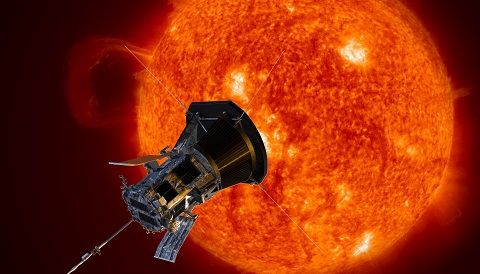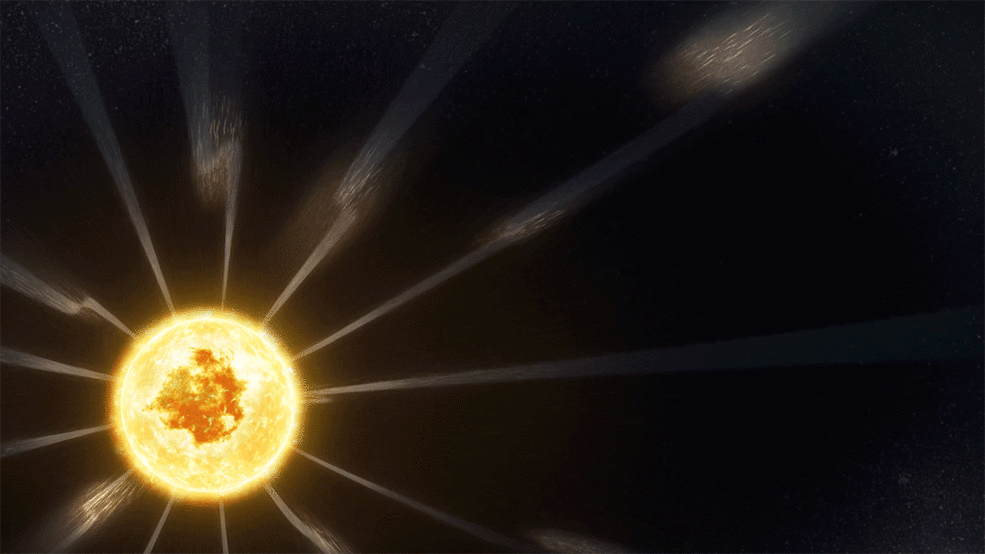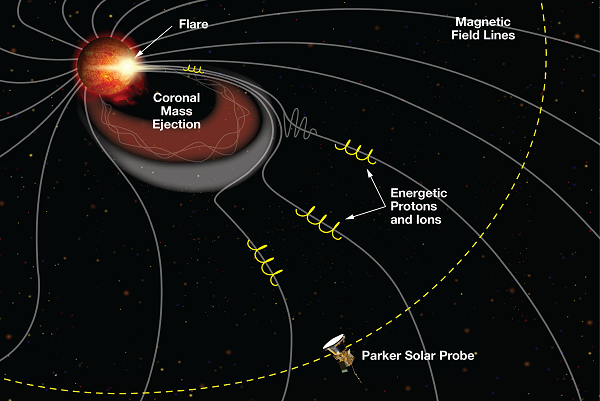First Science Returns from NASA’s Parker Solar Probe – Sky & Telescope
In the first public release of data from NASA’s flagship heliophysics mission, scientists on the Parker Solar Probe team reveal surprises and mysteries from our host star.

An artist’s concept shows the Parker Solar Probe nearing the Sun.
NASA / Johns Hopkins APL / Steve Gribben
We may not know our nearest star as well as we thought. Researchers for the Parker Solar Probe mission announced key findings Wednesday from the spacecraft’s first three perihelion passes in November 2018 and April 4 and September 1, 2019, when the spacecraft passed just 24 million kilometers (15 million miles) from the Sun.
The mission’s aim is to understand the source and structure of the Sun’s outer atmosphere and the solar wind that emanates from it. And the insights announced from the Parker Solar Probe team on Wednesday show just how much we are missing from our vantage point on Earth. The results appear in a series of four papers in the December 4th Nature.
Parker has made three of 24 planned passes by the Sun. Currently on a 150-day, elliptical orbit, the mission has already made the closest-ever approach, swooping past the Sun at just over half of Mercury’s distance at perihelion. Traveling at more than 95 kilometers per second (213,000 mph), Parker has also topped the speed record for the fastest spacecraft, set by the German-American Helios 2 mission in 1976.
The Parker Solar Probe is carrying four suites of instruments into the hostile territory near the Sun, including FIELDS, which investigates radio, magnetic, and electric fields; Solar Wind, Electrons, Alphas and Protons (SWEAP), designed to measure electrons and ions in the solar wind; Wide-field Imager for Solar Probe (WISPR), which images the Sun and corona on each perihelion pass; and Integrated Science Investigation of the Sun (ISʘIS).
The instruments are protected from the Sun’s extreme heat behind a carbon-composite shield, as the key science of the mission is done during each perihelion pass, when the spacecraft skims through the Sun’s outer atmosphere.
Rogue Waves the Solar Sea
One lingering mystery researchers hope Parker will help solve is the so-called coronal heating problem. Generally, temperatures decrease as you go away from a heat source, but in the case of the Sun, temperatures actually increase from the visible surface, where the Sun sizzles at 6000K (5700°C), out to the corona, which dazzles at a blazing 1 million to 2 million kelvins.
Scientists have known about this paradox since 1942, but only over the past decade or so have astronomers begun to suspect that Alfvénic waves might be transferring heat from the Sun’s visible surface to its corona. These waves travel along magnetic field lines loaded with plasma, like vibrations traveling along a plucked guitar string.
Researchers were expecting to see these waves strengthen as the probe neared the Sun. But they were in for a surprise. Not only were the waves stronger near the Sun, but the instruments also captured huge “rogue waves” sweeping by the spacecraft.
“When a rogue wave passed by the spacecraft, the speed of the wind could jump by more than 500,000 kilometers per hour in seconds,” says Kasper. “There were thousands of these rogue waves seen in the ten days we were near the Sun.”
Parker’s instruments recorded spikes of particle velocities, often accompanied by 180°-reversals in magnetic field. Also referred to as ‘switchbacks,’ these swift reversals last anywhere from a few seconds to a few minutes, as documented by the FIELDS and SWEAP instruments.
The mystery of the hot corona isn’t solved yet, but these observations show scientists where to look next.
“Now we can look at surface of the Sun to see what’s causing these [powerful waves] and launching them into space,” Kasper says. “We’ll be reaching out to the whole community to ask, what does Sun emit at that cadence, with that duration, with those properties, to be seen by the spacecraft.”

A depiction of ‘switchback’ events on the solar wind.
NASA / Conceptual Image Lab / Adriana Manrique Gutierrez
Surfing the Solar Wind
Another open question is the source and acceleration of the solar wind. “The corona produces a supersonic stream of particles that flow into space,” says SWEAP Principal Investigator Justin Kasper (University of Michigan), “and we would like to know why this wind is so fast.” The solar wind can accelerate up to 800 kilometers per second (2 million mph) above holes in the Sun’s corona.
Some of this speed comes from the Sun’s rotation. As the Sun spins, its magnetic field grips the corona and forces it to rotate as well, like riders on a merry-go-round. But Parker has now shown that this rotation is 15 to 25 times faster than predicted by standard models. SWEAP recorded rotation speeds exceeding predictions at 35 to 50 km/s. These findings challenge traditional models of how stars like our Sun lose angular momentum as they age and spin down over time.
“We are discovering that our standard models of the Sun are missing some very fundamental physics, and this mission has a great chance of revealing what is really happening,” says Kasper. “This might have implications for any spinning balls of plasma you can think of, like young stars, black hole accretion disks, and some plasma fusion devices.”
Dust-Free Zone
Another finding came from the WISPR instrument, which documented preliminary evidence of a dust-free region within 10 solar radii of the Sun.
On Earth, we see dust in the solar system as the zodiacal light, often visible at dusk or dawn. But for more than a century, scientists have predicted that the Sun’s heat should break apart dust near it, creating a dust-free zone. Previous missions have failed to see this dust-free zone, though. Now, WISPR’s observations suggest that the amount of dust decreases smoothly, rather than making an abrupt transition.
Parker will make even closer passes to the Sun starting in January 2020, when researchers will perhaps finally get to study this clear zone up close.
Storm Warning
The ISʘIS instrument measurs energetic particles from the Sun, and scientists soon realized that it could detect incoming solar storms. “Particles started arriving almost a day ahead of time,” says David McComas (Princeton). “They rush out ahead along magnetic field lines, like fish jumping upstream, arriving before the structure of the coronal mass ejection gets to the spacecraft.”

A schematic shows a coronal mass ejection, during which a burst of material with as much mass as Lake Michigan is blasted away from the Sun. Parker can detect such incoming solar storms by the energetic particles that precede them.
NASA / Goddard
ISʘIS could also detect far smaller solar bursts than ever before, including rare bursts made up of heavier elements, suggesting such events are more common than previously thought. Understanding these micro-bursts at their origin is crucial to understanding how space weather evolves between its origin and Earth, where it can impact satellites and astronauts.
More to Come
All of the data coming out of the mission is now available online. It’s a good time to study the Sun, as we’re now in the heart of a profound solar minima, and the awaited onset of solar cycle #25. Observing at the start of a solar minimum, when the Sun is at its quietest and its magnetic field is at its simplest, gives researchers a baseline to reference before things ramp up towards solar maximum.
The Parker Solar Probe will also make the second of seven Venus flybys this month on the day after Christmas, flying just over 3,000 kilometers (1,864 miles) past the planet.
The Parker Solar Probe is named after solar physics pioneer Eugene Parker. The mission is expected to last through a primary mission of almost seven years, through 24 solar orbits. By 2025, Parker will be passing just 7 million km from the Sun at a speed of 430,000 mph, making it by far the fastest artificial object ever fielded by humanity.

The position of the Parker Solar Probe during perihelion three.
NASA / JHU / APL
It’s a great time to study the Sun, as the Parker Solar Probe dips into the very heart of the solar system to unlock the Sun’s deepest secrets.





